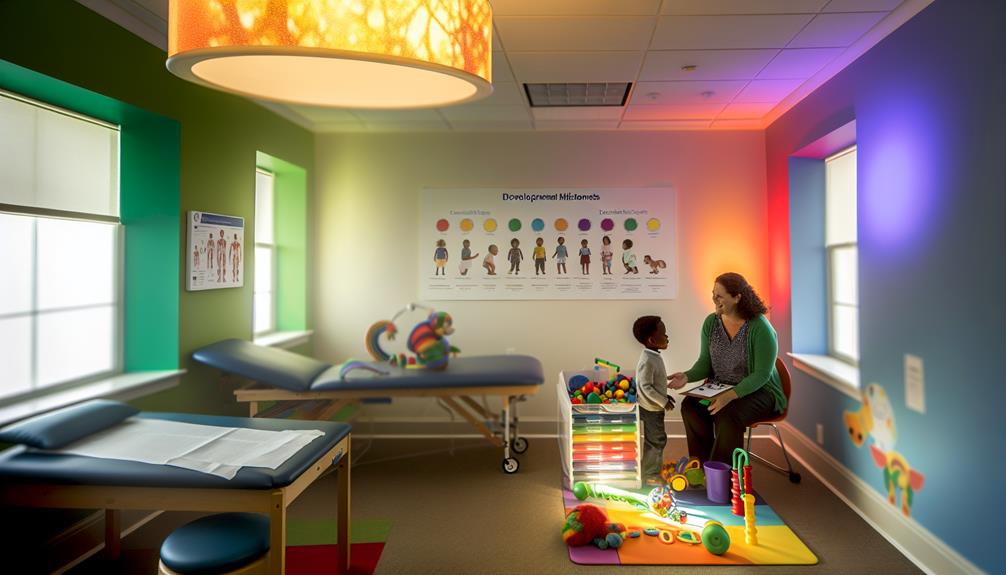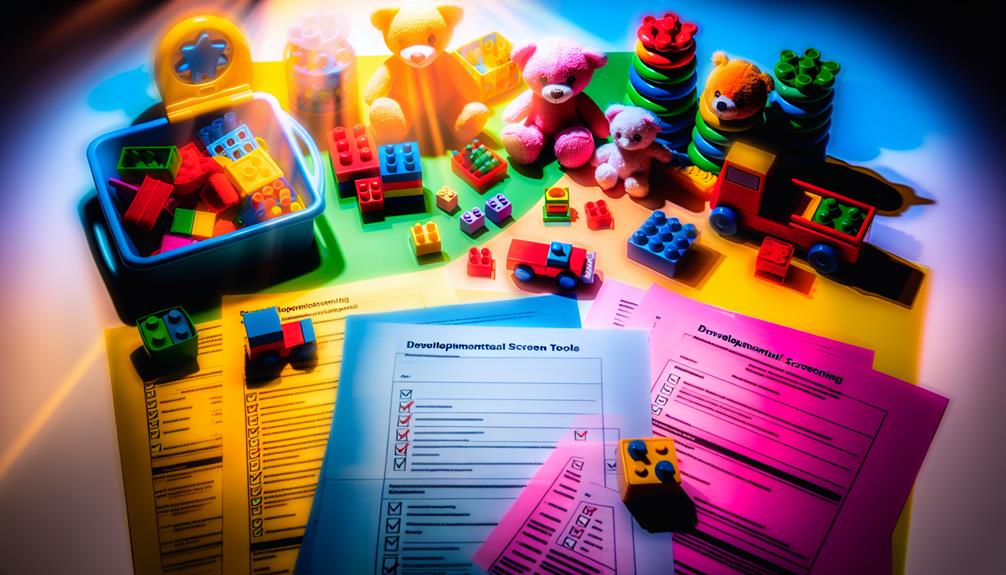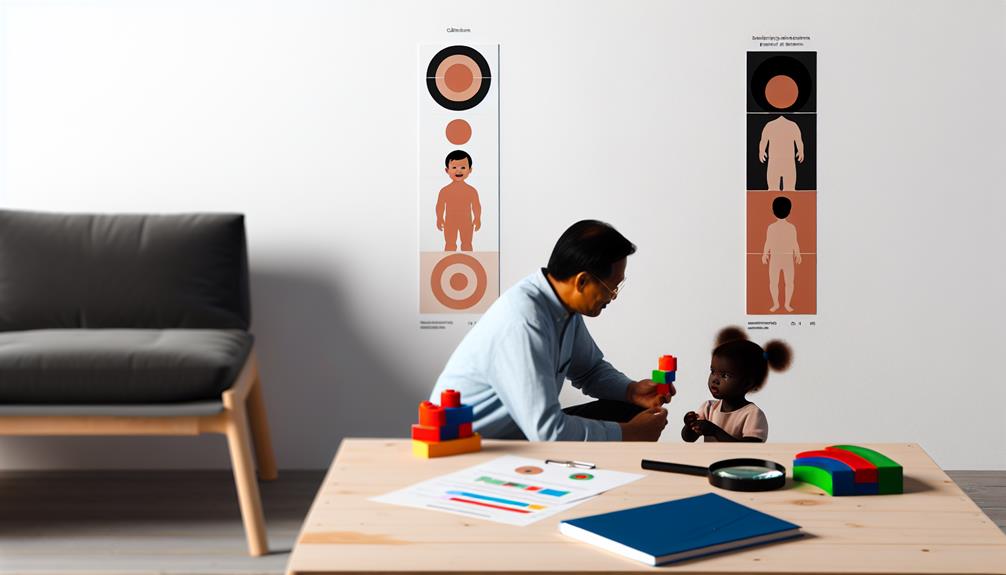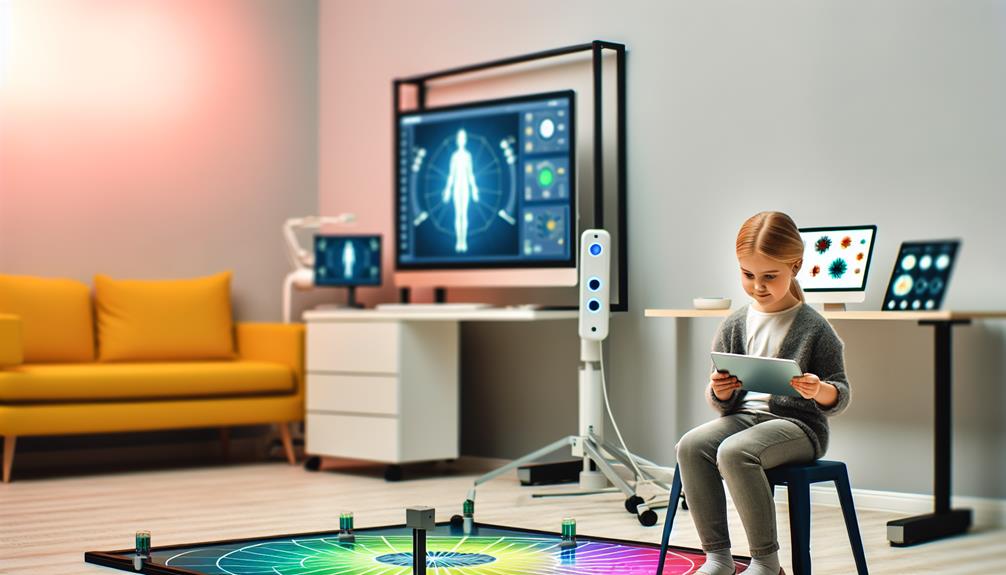5 Essential Tools for Early Autism Diagnosis

To enhance early autism diagnosis, you can use five essential tools. First, developmental screening tools help evaluate your child’s skills and identify concerns early. Next, behavioral checklists provide a framework to assess specific areas of difficulty. Parental observation guides allow you to monitor development and identify red flags. Diagnostic assessment instruments offer a thorough understanding of your child’s
unique needs. Finally, technology-enhanced evaluation methods make it easy to conduct assessments through telehealth and virtual simulations. Collectively, these tools can greatly enhance intervention strategies. Discover more about how these tools can benefit you and your child.
Key Takeaways
- Developmental screening tools provide structured evaluations to assess skills and identify concerns early for timely intervention.
- Behavioral checklists offer a clear framework to pinpoint specific difficulties and aid in early intervention strategies.
- Parental observation guides empower parents to actively monitor development and communicate potential red flags to professionals.
- Diagnostic assessment instruments are essential for accurately diagnosing autism spectrum disorders and understanding unique sensory processing challenges.
- Technology-enhanced evaluation methods utilize telehealth and virtual simulations to assess social behaviors conveniently and provide detailed insights.
Developmental Screening Tools

How can developmental screening tools make a difference in identifying autism early? These tools provide a structured way to evaluate your child’s skills in areas like sensory processing and social communication. By using standardized questionnaires or checklists, you can gain insights into your child’s development, pinpointing possible concerns before they become more prominent.
When you observe your child’s responses in different environments, developmental screening tools help you note any unusual sensory processing patterns, such as heightened sensitivity to sounds or textures. Recognizing these signs early can lead to timely interventions, making a significant impact on your child’s future.
Moreover, these tools focus on social communication milestones, evaluating how your child interacts with others. Are they making eye contact, engaging in back-and-forth conversations, or showing interest in playing with peers?
A thorough evaluation using developmental screening tools sheds light on these critical aspects, guiding you and healthcare professionals in identifying potential developmental delays.
Behavioral Checklists
Behavioral checklists serve as valuable tools for identifying signs of autism by providing a clear framework to assess your child’s behaviors and interactions. These checklists can help you pinpoint specific areas where your child may be experiencing difficulties, such as sensory processing challenges or social engagement issues. Early intervention is essential, and using these checklists enables you to gather essential information that can guide professionals in making informed decisions.
Here’s a simple checklist to review:
|
Behavior |
Observed? |
Notes |
|
Limited eye contact |
Yes/No |
|
|
Difficulty with changes |
Yes/No |
|
|
Repetitive movements |
Yes/No |
|
|
Unusual sensory responses |
Yes/No |
|
|
Lack of interest in social play |
Yes/No |
Parental Observation Guides

In addition to behavioral checklists, parental observation guides play a vital role in monitoring your child’s development. These guides empower you to actively track your child’s progress and identify any potential red flags, making your observations crucial for early intervention. By focusing on communication milestones, you can gauge whether your child is developing social skills at a standard pace.
Parental involvement is key in this process. As you observe your child’s interactions, note their ability to make eye contact, respond to their name, or use gestures. These are fundamental indicators of their communication development. If you notice any inconsistencies or delays, it’s important to document these observations and discuss them with a professional.
Using parental observation guides helps you become more attuned to your child’s unique behaviors and needs. They provide a structured way to capture your thoughts and concerns, leading to more informed conversations with healthcare providers. Remember, your insights are invaluable in ensuring your child receives the right support and resources early on.
Diagnostic Assessment Instruments
When it comes to diagnosing autism, a variety of diagnostic assessment tools are available to professionals. These instruments are crucial for identifying autism spectrum disorders, especially during the critical window for early intervention. You’ll find standardized evaluations, observational lists, and parent-report surveys among the most common tools.
At Spectrum Works, we provide comprehensive ABA therapy services tailored to meet each child’s unique developmental needs. We use these essential tools to offer early autism diagnosis and intervention, helping children and families receive the support they need. To learn more about how Spectrum Works can assist your family, visit spectrumworksmn.com.
Standardized evaluations, like the Autism Diagnostic Observation Schedule (ADOS), help professionals assess a child’s communication, social interaction, and play skills. Observational lists allow you to monitor specific behaviors over time, providing insight into sensory processing challenges that a child might face.
For instance, some children may be overly sensitive to sounds or textures, which can greatly impact their daily life.
Parent-report surveys, such as the Social Responsiveness Scale (SRS), offer another valuable perspective by collecting information on your child’s behavior in various situations. Using a combination of these diagnostic tools enables a thorough understanding of your child’s unique needs.
This detailed approach not only aids in diagnosis but also guides appropriate early intervention strategies, allowing you to support your child’s development effectively.
Technology-Enhanced Evaluation Methods

Frequently, technology-enhanced evaluation methods are revolutionizing the way autism is diagnosed. These innovative approaches make it easier for you and healthcare professionals to gather essential information quickly and efficiently. Telehealth assessments allow parents to connect with experts from the comfort of home, reducing barriers to access and providing timely evaluations.
Additionally, virtual reality simulations create immersive environments where children can interact and respond to various stimuli. This can help assess social behaviors in ways conventional methods can’t.
Here’s a quick comparison of these methods:
|
Method |
Benefits |
|
Telehealth Assessments |
Convenient, accessible, timely |
|
Virtual Reality Simulations |
Engaging, realistic, interactive |
|
Traditional Assessments |
Established, thorough, familiar |
|
Parent-Reported Tools |
Insightful, personal, detailed |
Frequently Asked Questions (FAQs)
What Age Should I Start Screening My Child for Autism?
You should start screening your child for autism as early as 18 months, especially if you have parental concerns. Pediatrician input can guide you, and early intervention, along with family support, can make a significant difference.
How Often Should Developmental Screenings Be Conducted?
You should conduct developmental screenings regularly, ideally at key milestones. This frequency helps identify any concerns early, creating valuable early intervention opportunities that can greatly enhance your child’s development and overall well-being.
Are There Any Cultural Considerations in Autism Diagnosis?
When considering autism diagnosis, you should recognize cross-cultural differences that influence perceptions and understanding. These variations can create diagnostic challenges, making it essential to approach assessments with sensitivity to cultural backgrounds and communication styles.
Can Autism Be Diagnosed Without a Formal Assessment?
While autism can’t be definitively diagnosed without a formal assessment, parental observations and behavioral cues, along with medical history, can guide early interventions and highlight potential concerns for further evaluation by professionals.
What Are the Consequences of a Late Autism Diagnosis?
A late autism diagnosis can lead to long-term impacts, like increased social challenges. You might struggle with relationships, education, and emotional well-being, making it harder to navigate life’s complexities and achieve personal goals effectively.
Conclusion
To wrap up, utilizing these five vital tools can greatly improve early autism diagnosis. By integrating developmental screening tools, behavioral checklists, parental observation guides, diagnostic assessment instruments, and technology-enhanced evaluation methods, you can gain a clearer understanding of a child’s unique needs. Early intervention is essential, so don’t hesitate to leverage these resources to support children and their families. Together, we can pave the way for a brighter future for those on the autism spectrum.
